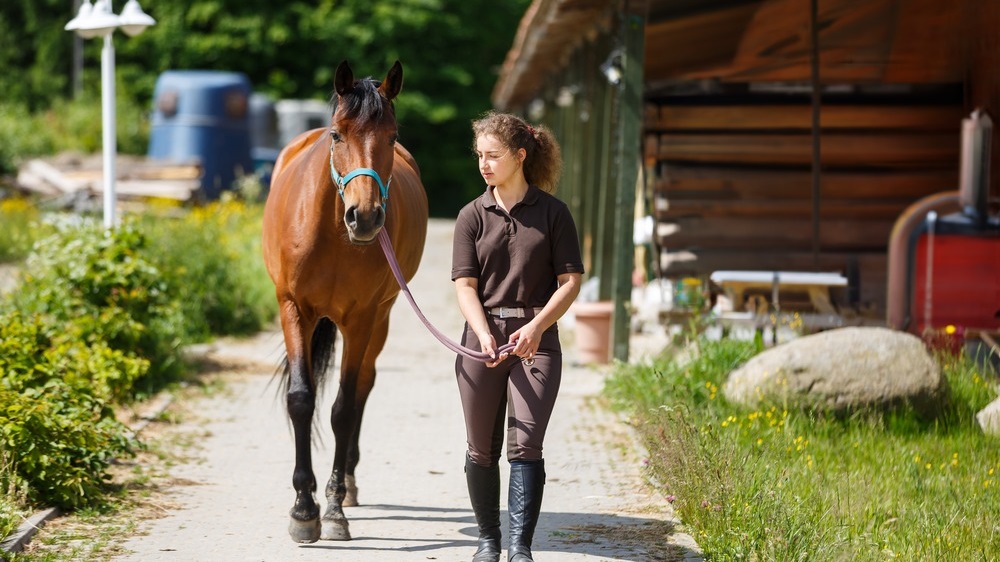Whinny’s Wisdoms

Hi everyone, Whinny here! It’s starting to cool off a teeny bit here in Florida, and a lot of you are gearing up for the riding season! We don’t want anything to get in the way of the fun stuff you’re planning with your horse this Autumn. My Springhill Equine vets love to keep your horse feeling good and performing up to his potential, no matter whether you’re a show jumper, reiner, trail rider, or anything in between!
Lameness evaluation and treatment is one of the most common things they work on. But the first step is for you to recognize the start of an issue at home, so let’s talk about what to look for. Some lameness is really obvious, like if your horse is limping badly on one foot, but a lot of the time it’s much more subtle! You may just notice a change in his performance, such as trouble making tight turns around the barrel, difficulty picking up one canter lead, or acting cranky out on the trails. Once you notice something is amiss, here’s what my vets will look for when they’re evaluating your horse move.
What does lameness look like?
If you drive by my clinic, you will often see horses being trotted up and down the grass outside the clinic while my vets watch them. This is the Springhill technicians’ favorite part of the day. They just love the healthy exercise, especially at noon in July and August!
So what does it look like when a horse is lame? It can be an obvious limp in a forelimb lameness. Your horse may not want to bear weight on the leg or may have a pronounced “head bob” when he walks or trots. For a forelimb lameness, think “down on sound” – meaning the head bobs downwards when the sound (non-lame) leg hits the ground. So, if the head bobs down when the left front foot hits the ground, the lameness is on the right front leg. For a mild lameness, there may not be a super obvious head bob, especially when he’s moving on a straight line. My vets will also listen to the sound of his footfalls – a lame horse will land softer on the foot that hurts, as he shifts his weight to avoid pain. If both forelimbs hurt equally, you might not see a head bob, but your horse could look stiff when he’s moving, or rock his weight back onto his hind end to take weight off the front.

Hindlimb lameness is evaluated differently than forelimb lameness. It may look like a “hip hike”, toe dragging, or a shortened stride on the lame hindlimb. It can also just manifest as problems picking up or keeping the canter leads, lack of impulsion, or even “crow hopping” or bucking. Don’t worry if you aren’t sure, hindlimb lameness can be tricky to see – that’s what my vets are for. If you’re feeling like something doesn’t seem right, just call us!
Some lameness is more subtle than others. If your horse is quite sore, my vets may just need to see him walk and may not need him to trot. For most lameness cases though, the horse is evaluated at the trot, because the symmetrical nature of the normal trot gait makes abnormalities more apparent. Sometimes my vet will ask to see a horse canter to check out how the hind end moves. She’ll want to see the horse move on a straight line and may want to see him moving in a circle (such as on a longe line) to see how positioning his limbs on the inside or outside of the circle will affect his lameness. Some lameness is only noticeable when the horse is turning. The ground surface makes a difference too – your horse may look fine on grass or soft sand but be sore when the ground is harder. That’s typical of a hoof problem or arthritis. A soft tissue injury like tendinitis may be more painful on deep, soft footing. So my vet may ask her tech to jog your horse on an asphalt surface instead of the grass to check out the difference.
Here’s one thing I want you to understand – horses don’t lie about lameness. Their brains don’t work that way. Your horse isn’t “faking” a lameness when you ride him just because he doesn’t look as lame when you see him cantering in the field. He isn’t capable of that. Some things, like the additional weight of carrying a rider, or the specific motions he is asked to do under saddle, just make a lameness more apparent. So, if you notice lameness when you ride, just schedule a lameness exam with my vets instead of thinking your horse is being tricksy.
In my next blog on the lameness exam, we’ll talk about the steps my Springhill vets take to determine what’s hurting your horse, and how to help him!
Until next week,
~Whinny
P.S. Did you know the humans here at Springhill Equine have the biggest, most popular equine veterinary podcast in the world? It’s called Straight from the Horse Doctor’s Mouth. Each episode (and there are over 130 and counting) covers a horse-health topic and is directed at horse owners so they can learn how to take the best care of their horses. You can check it out right over on the Podcast Page of my website, or subscribe on Spotify, Apple Podcasts, or wherever you get your podcasts.
 Whinny’s Wisdoms is the official blog of Whinny the Clinic Mouse at Springhill Equine Veterinary Clinic in Newberry, Florida. If you liked this blog, please subscribe below, and share it with your friends on social media! For more information, please call us at (352) 472-1620, visit our website at SpringhillEquine.com, or follow us on Facebook!
Whinny’s Wisdoms is the official blog of Whinny the Clinic Mouse at Springhill Equine Veterinary Clinic in Newberry, Florida. If you liked this blog, please subscribe below, and share it with your friends on social media! For more information, please call us at (352) 472-1620, visit our website at SpringhillEquine.com, or follow us on Facebook!
[jetpack_subscription_form title="Subscribe to Whinny's Wisdoms"]

